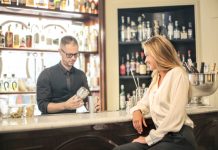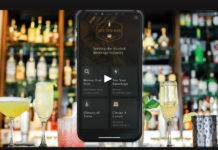
The following is a continuation of an article from our October 2013 issue about Bordeaux wine bars:
As sophisticated wine bars take flight across the U.S., so do the expectations of increasingly diverse and savvy wine drinkers. What better place than Bordeaux, France to learn the nuances behind successful wine bar concepts.
By Elyse Glickman
Max Bordeaux takes the concept of “wine as art” literally. The gallery looking space, complete with sculptural wine towers, sleek Enomatic machines, plush furniture and glasses suspended from the ceiling is a showcase for about 48 of Bordeaux’s best Grands Crus wines. While a “tasting card” will run guests from €20-30, ($26-40 U.S.) and prices go up to €45-60+ ($60-80) for tastes of the top echelon 1st Growths and Super Seconds (we’re talking Chateau Lafon-Rochet, Close Fourtet and Domaine de Cheval), Canadian-born sommelier-in-residence Leagh Barkley argues that Max Bordeaux offers great value for customers wanting to dive deeper into their knowledge and appreciation of wine.
“What is most striking about this bar is that it is not at all traditional,” affirms Barkley. “While there are lots of great wine bars in Bordeaux, they are created with a certain standard. (Our location is focused on) the modern and the traditional coexisting, which also nicely represents what Bordeaux is all about today.”
Barkley adds that in order to keep Max Winebar relevant to trade and consumers, the space has offer the perfect balance of education, comfort and glamour–much like some of top Bordeaux marques (producer brands) as well as ambitious releases by small producers.
“Our look is especially important when you consider that customers are surrounded by wines at better wine bars that are often approached with pretension at times given their pedigree and their fame outside of France,” continues Barkley. “To make an ambiance that is not stuffy, giving customers of all experience levels to feel welcome and included. We also feature wines that are good quality for their prices in order to introduce customers to different styles of a certain appellation or expression. From there, we work them into those wines so the experience is not intimidating.”
Barkley is also a believer that no matter where in the world your wine bar is located, educating younger customers as well as industry professionals helps many sectors, from the producers to other related businesses.
“People can come in and start enjoying wines at an early age without going to (such sub par things) as the white zinfandel for example,” he says. “Why not bring them into the world of wines through good quality wines to begin with? Why not take the fear out of it?”
Barkley’s logic is that if a person under 30 comes into a wine bar and senses the experience will be snobby, they won’t want to be looked down on and leave. However, by educating and welcoming prospective customers and encouraging repeat business, your establishment will not only benefit, but retailers as well, as the sommelier or program has taken the fear out of the equation. Max Bordeaux’s loyalty programs include special student prices for different events, as well as including excellent lower priced representations of a certain red or white to use as a teaching tool alongside the top wineries represented.
“As a wine bar owner or sommelier, don’t be aggressive but be open and warm,” says Barkley. “If they apologize about not knowing more about wine, reassure them and tell them that’s what you’re here for. Ask them about the foods and beverages they like. Ask them if they would like fruity red wines or more refreshing whites, then guide them towards wines that appeal to their tastes. From there, you have seized an opportunity to teach your customers something new. Help them build their confidence and motivation to try more.”
How do you build loyalty and raise your bottom line? Stage creative monthly events, and structure them as a VIP experience, according to Barkley. Start by creating an email list of customers, and send them monthly information on that month’s tasting event. While some of the money covers food that may be brought in for the tasting, and some of the pours themselves, Barkley explains an amount of the admission will go on to a credit card that he or she can use for future visits and tastings.
From the Classroom to the Crus The classroom is one of Max Bordeaux’s cornerstones, even if the space can also be seen as the Cartier of the area’s wine offerings. However, if that’s true, The Bordeaux Wine School and Bar à Vin–both operated by Conseil Interprofessionnel du Vin de Bordeaux (CIVB)–could perhaps serve as the Sorbonne for consumers, overseas buyers and importers and, yes, sommeliers and wine bar owners from the States who literally want to prep themselves with knowledge before going out into the fields, from the Medoc and St. Emilion to the paths less traveled worthy of discovery.
The bar (a mix of art deco and mid-century modern décor inside a 18th century building renovated by architect Françoise Bousquet) offers a rotating selection of 30 Bordeaux reds, whites, rosés, and sparkling wines, complete with information sheets available for each. Wines are served by the glass and can be accompanied with a plate of cheese or charcuterie.
While this destination is recommended by guides and wineries as the starting point for a week of winery visits, and the management emphasizes some elements of its concept cannot be duplicated by wine bar owners in other locations, its approach can be seen as a sort of GPS for wine bar owners and sommelier to navigate the journeys of different wines from field to table.
Guillaume Gresta, Bar à Vin’s manager, also points out that the presence of young sommeliers tracking wine buying and consumption trends adds relevance and excitement to wine discovery for drinkers of all ages and levels of experience. “Like the wines of Bordeaux, the team at the Bar à Vin is a blend of dedicated, passionate professionals who come together in a wonderful mixture of characters, nationalities and abilities,” he says. “Each of these sommeliers and wine advisors bring their own unique qualities, much like the different grape varieties and terroirs of Bordeaux.”
Out on the floor, one of the staff sommeliers points out that this bar curates its ever-changing collection of wines and customers in some of the same ways other successful local wine bars do. He considers the wine school, meanwhile, an essential step for those business owners and sommeliers who want to learn the unique story and behind-the-scenes history of Bordeaux so they in turn can relay that story to their customers at home, enriching the overall experience.
“We encourage American professionals to go to our wine school first to build upon their existing level of knowledge before going to the vineyards,” he says, echoing the sentiments of Gresta and the management. “As the core concept of this bar is that we exclusively serve Bordeaux wines, our wine advisors are trained extensively on the appellations, so they can discuss the unique characteristics of the various Bordeaux wines available. Constant training is always is important as the selections at our bar changes regularly.”
Although at press time, the CIVB was researching locations for a Bordeaux-focused wine bar with the same specialized focused in the U.S., what bar sommeliers and wine bar entrepreneurs can immediately take away is that while life for a good wine begins in the vineyards, it can grow, evolve and mature in the hands of a good educator. On the consumer side and for the benefit of producers and their distributors and merchants, these business owners can ensure each worthwhile bottle will take on a life of its own.
** To read the first half of this story, check out the digital edition of our October 2013 issue here:
http://issuu.com/barbusinessmagazine/docs/october_2013_bar_business_magazine/34








